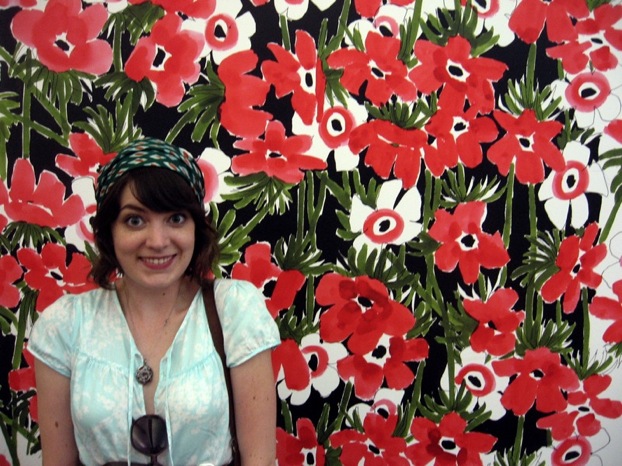Vera, An Ordinary Love
Vera intended her work as a way to incorporate something beautiful and thoughtfully-rendered into everyday life, whether spread out on a breakfast table or covering a bed or knotted around a neck. Formally trained at New York City's Cooper Union, she made “wearable art” at a time when that was either a novelty or a…

My sister Sarah first fell in love with Vera sometime last year—Vera being a lady, of course, but also a brand, a style, maybe even an idea of how life should be lived.
It started with scarves, I think. Last summer, Sarah was visiting me in Atlanta and we were browsing an antiques store; I wandered away from her for a bit, and when I found her again she was clutching a reddish-brown, leaf-printed scarf to her chest like it was a holy relic. It was priced at $18, more than either of us cheapskates tend to spend on any one small, secondhand thing. “But it’s Vera,” she sighed, and so it was bought.
Back home, it joined her small but already-growing collection of other vibrantly-hued and patterned silk scarves, a jumbled parade of foliage and splotches and geometric madness, each piece bearing the same black, half-cursive signature in one corner: Vera.
Sarah’s hardly the first to fall under the spell. Vera Neumann was born in Stamford, Ct. in 1907, and by the 1950s, that delicate scrawl of hers had become synonymous with a certain sort of lovely yet functional, everywoman style. These days, the designer is remembered mostly for her scarves, but she started out on placemats and eventually designed nearly every sort of home textile common to late-midcentury middle America—aprons, napkins, bedsheets. One of her prints adorned the sunroom of the Truman-era White House, but that may have been a populous-baiting move, because the real beauty of Vera’s work—besides her simple yet bold color choices and the restrained whimsy of her hand-drawn patterns—was its accessibility.
Vera intended her work as a way to incorporate something beautiful and thoughtfully-rendered into everyday life, whether spread out on a breakfast table or covering a bed or knotted around a neck. Formally trained at New York City’s Cooper Union, she made “wearable art” at a time when that was either a novelty or a luxury, decades before the idea became unfortunately associated with over-embellished denim vests hawked at craft shows and country fairs. She predated, too, the rise in recent years of high-end designers partnering with retailers like Target to bring tweaked versions of their lines to the masses—not to mention our ability to saunter into any given department store or log online to find more artfully designed t-shirts and home goods than you could shake an old scarf at.
Both during her life and since her death in 1993, though, her work has found its way back to the gallery walls that she deliberately tried to liberate art from. (A recent spike in popularity is probably thanks to the release, earlier this year, of Vera: The Art and Life of an Icon, partly spearheaded by her legacy-maintaining Vera Company and sold widely in Anthropologie stores, which also stocked a line of home goods based on original Vera designs.) Late this spring, Sarah came to visit again and we wandered through the entirety of the Atlanta Botanical Garden campus in search of their “Vera: The Lady Behind the Ladybug” exhibit. It amounted to little more than a dozen or so paintings (originals and reproductions) and textiles mounted in a hallway and in a small conference room, uncleaned after some sort of afternoon seminar, but we kicked aside the potato chip bags and half-drained Diet Coke cans to peer closer at the prints: watermelon, eggplants, carrots, swarms of tiny ladybugs. I took Sarah’s photo in front of one of the bigger pieces, a huge field of red poppy-like flowers. She has a green and white Vera scarf tied around her head, and she’s grinning like a girl posessed.

We peered askance at the accompanying tags, too, noting the irony of works by an artist so set of making her work widely-available to all being priced so inaccessibly—but that’s the cost of being beloved, I guess. Fortunately, owning one—or many—of the real things is far less daunting. Sarah has amassed her continually-growing collection from antique shops, thrift stores and especially Etsy, where it’s dangerously easy to find really wonderful, ridiculously affordable pieces—just search for “Vera” under their vintage listings, sort by price and browse til you hit your budget’s upper threshold.
There’s almost always a huge array of scarves, placemats and napkins. Occasionally you’ll find some some bedsheets, too; lately, Sarah has had her eyes on a certain butterflies-and-fern print, which originally came in a few different, very distinctly-1970s colorways. Our mom found a queen-sized fitted sheet in orange at a thrift store recently, and while Sarah ceded the $4.50 purchase to me for lack of a right-sized bed, I know she’s still on the prowl. When we were little, we had a twin-sized set of the green ones, likely passed down from our grandmother to our mom, that spent some time on our beds and at least once followed me to sleep-away Girl Scout camp. Sarah realized they were Vera sheets sometime earlier this year and went searching in our parents’ linen closet for them, only to find out our mom had gotten rid of them years ago, not having any idea what they were (or at least not anticipating her younger daughter’s strange textiles obsession years in advance). Who knows where they are now—maybe they were some other small-time collector’s lucky thrift-store find, or maybe they were scooped up by someone who also had no idea about them, who picked them up as a cheap, kinda-cute-in-an-ugly-way secondhand find, clueless about that little name in the corner. A small tragedy, perhaps. But I imagine Vera herself might approve. ![]()
var ve_publisher = “ThoughtCatalog”;
var ve_site = “THOUGHTCATALOG”;
var ve_area = “THOUGHTCATALOG”;
var ve_location = “THOUGHTCATALOG_STORY_TWIG_BOTTOM”;
var ve_placement = “twig_bottom”;
var ve_width = 0;
var ve_height = 0;
var ve_alternate = “”;
document.write(“”);




